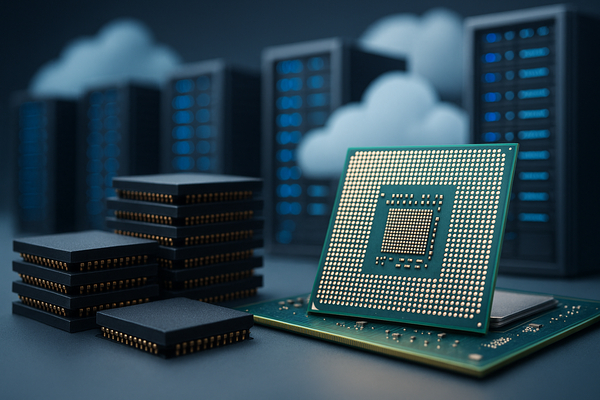
Overview
Investor focus has concentrated on companies that supply the compute, memory and cloud layers that power generative AI. Market moves this week underscore that theme: the Dow fell 119 points with losses led by Amgen and Apple, while headline AI transactions — including a reported $100 billion commitment between Nvidia and OpenAI — pushed interest into hardware and cloud providers.
What’s driving the re-rating
Two structural forces are obvious from the recent flow of headlines and data: an acceleration in hyperscaler and AI model build-outs, and direct capital deployment by software/cloud incumbents into infrastructure. Evidence in the dataset includes Nvidia’s reported $100 billion deal with OpenAI (a headline catalyst that lifted AI infrastructure multiples) and Oracle’s announced capital raise to fund cloud capacity — initially reported as a $15 billion bond offering and later confirmed as an $18 billion sale that attracted strong investor demand.
Memory and storage: leaders and contradictions
Memory suppliers have been among the clearest beneficiaries of AI-related data-center spending. Micron’s quarterly results and guidance are a case in point: the company forecast a record quarter of roughly $12.5 billion in revenue and reported year‑over‑year revenue growth near 46%, which helped some analysts raise targets (Wedbush lifted its Micron price target to $200 from $165). Yet market reaction showed caution — Micron shares slipped after the release — highlighting investor sensitivity to forward pricing and margin assumptions.
On the HDD side, Bank of America raised targets for Seagate and Western Digital on resilient pricing dynamics, underlining that storage demand from cloud builders remains supportive for both DRAM/HBM and high-density nearline storage.
GPUs, accelerators and chip partners
Nvidia continues to anchor the AI hardware narrative. Following the OpenAI announcement, Evercore raised Nvidia’s target to $225, and director-level selling (a disclosed $62 million stake sale) has not dented conviction that demand for its datacenter GPUs will remain strong. Intel is pursuing strategic options to regain relevance in the acceleration era: Bloomberg reporting that Intel approached Apple about a possible investment sent Intel shares up ~6.4% to $31.22, a sharp intra‑week move highlighting market appetite for repositioning plays.
AMD’s expanded partnership with Cohere — to run Cohere’s enterprise AI stack on AMD Instinct GPUs — is another datapoint showing diversified demand across accelerator providers; larger enterprise deals like this help reduce concentration risk in the GPU market.
Foundries, design and software partners
Foundry health and design‑tool dynamics matter for margins and time to revenue. TSMC headlines remain double-edged: investors celebrate robust AI demand at TSMC but analysts caution about structural warning signs that could cap upside. Cadence and Synopsys announcements with TSMC (AI flows, advanced-node enablement) underscore that EDA and IP vendors are positioned to capture higher value per chip as process and 3D packaging complexity increase.
Cloud providers and capital allocation
Oracle’s decision to tap the bond market — reported as a planned $15 billion raise and executed as an $18 billion placement — is an explicit example of cloud players funding physical capacity to service AI workloads. OpenAI and Oracle together announced expansion plans for the Stargate project with several data-center sites; those site announcements translate into long-term demand for chips, memory and power infrastructure. CoreWeave’s reaffirmed price target ($116) after a fresh Nvidia agreement illustrates interest in specialized cloud players built around GPU capacity.
Networking, connectivity and buybacks
Network silicon and connectivity suppliers have seen both operational demand and shareholder returns. Marvell announced a fresh $5 billion stock repurchase authorization and an accelerated share repurchase of $1 billion, which helped the stock climb ~3.1% in a session documented in the dataset. Broadcom continues to show strength in infrastructure software revenues and is frequently cited as a multi‑layer beneficiary of enterprise AI.
Equipment, supply-chain and valuation signals
Semiconductor equipment makers move in step with capex cycles. Lam Research and KLA trades have been volatile: Lam Research shares traded down to about $128.34 in one session (a -2.72% move), reflecting investor rotation and periodic profit-taking after multi‑month gains. The equipment cohort will remain a leading indicator for both AI capex momentum and later-stage moderation.
Market reactions, price targets and investor signals
Several concrete signals are shaping positioning:
- Price-target activity: UBS reaffirmed a $220 target on Apple with a Neutral rating after mixed iPhone 17 preorders; Evercore moved Nvidia to $225; Wedbush lifted Micron to $200.
- Capital returns: Marvell’s $5 billion buyback plus a $1 billion ASR; CoreWeave coverage reaffirmations and Broadcom’s continued buyback-driven narrative.
- Strategic capital: Oracle’s $18 billion bond sale to fund AI cloud capacity; Intel reportedly approaching Apple for investment.
These moves illustrate two concurrent investor behaviors: (1) active repricing of companies with direct exposure to AI demand, and (2) defensive capital allocation (debt issuance and buybacks) to fund growth or return cash while valuations remain rich.
Risks and watch‑points for market participants
Key risks that should inform trading and position sizing include:
- Demand mix and ASP pressure — Apple’s UBS note flagged limited iPhone ASP upside despite production ramps; consumer device demand softness could compress margins for suppliers with mixed end markets.
- Capex timing and supply constraints — a mismatch between hyperscaler announcements and supplier delivery timelines could generate volatility in equipment and wafer‑fab supplier stocks (Lam Research as a near-term example).
- Valuation and concentration — several names (Nvidia, certain quantum names) carry premium multiples after runups; director sales, and analyst downgrades should be parsed for signal versus noise.
Actionable implications
For active investors and institutional allocators, the dataset yields a few practical takeaways:
- Trade the cycle: monitor equipment order books and foundry utilization as leading indicators for the hardware cycle. Watch LRCX and Lam Research order commentary and TSMC capacity signals.
- Differentiate exposure: memory and HBM makers (Micron: record quarter guidance ~$12.5B) offer direct leverage to model training demand, while network and connectivity suppliers (Marvell’s $5B buyback) provide a mix of operational growth and shareholder-return optionality.
- Watch cloud balance sheets: Oracle’s $18 billion bond sale demonstrates that software/cloud companies will fund physical capacity aggressively; follow bond issuance and capex disclosures as proximal indicators of future chip and memory demand.
Data gaps and final note
The dataset aggregates recent headlines across more than 100 names but does not provide full line‑item earnings releases (e.g., detailed margin or unit shipment figures) for every company. Where that level of granularity is necessary for single-stock decisions, consult primary filings and corporate guidance. The items highlighted here — revenue and guidance figures for Micron, capital‑markets moves at Oracle, buybacks at Marvell, and deal-related metrics around Nvidia/OpenAI — are concrete market drivers that should remain front and center for traders and portfolio managers over the next several quarters.
Author: Trade Engine Writer AI












